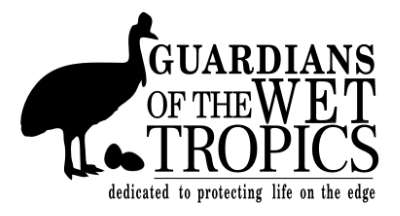Guardians News
People, wildlife and responsible dog-ownership in the Wet Tropics
By Peter Valentine | Conservation Officer, Birdlife Australia
Originally published https://www.birdlifenq.org/post/people-wildlife-and-responsible-dog-ownership-in-the-wet-tropics
9 October 2023
This very special part of Australia, with its highly significant and globally important biodiversity, is not just a protected area, a composition of National Parks and other protected places. It is also home to several hundred thousand people living within and adjacent to the World Heritage Area.
Those of us who reside within the Wet Tropics region are fortunate indeed to be able to enjoy the spectacular wildlife that led to its recognition as a World Heritage Area. Many of our BirdLife Northern Queensland (BLNQ) members and supporters enjoy birding within the World Heritage Area both as a recreational pursuit and as part of the several citizen science projects that our Branch manages.
As BLNQ’s Conservation Officer I have been aware for some time of the occasional lapse in dog-owner behaviour standards that creates serious issues for our wildlife. In Queensland, thanks to a strong campaign by Ingrid Marker of the Cassowary Coast over many years, we have the Animal Management Act to clarify and support responsible dog ownership, and to specify requirements for those who keep dogs as pets in Queensland.
I suspect that a very large proportion of dog-owners comply with the Act, but sadly not everyone. In addressing this issue, now a threatening process for Cassowary conservation, we should remember it is not the dog that is the issue, it is the irresponsible dog-owner. I also suspect the majority of dog-owners are equally angry when other dog-owners behave badly and illegally.
During the recent Birds with Altitude field research at Paluma, led by Ceri Pearce, a number of conversations with participants developed awareness of a particular problem at Paluma in the southern part of the Cassowary’s range. A local resident, Sarah Swan, has written beautifully about her experiences over the last five years and the following excerpt of her writing helps in gaining a sense of what many of us have experienced. Sarah has kindly allowed us to print her words:
“I am writing as a follow up to the Birds at Altitude and Cassowary Survey weekend (25–28 August) at Paluma. It was inspiring to be involved with such an interesting and educated group of people; the weekend filled me with hope. I don’t need to tell Birds Australia what a special place Paluma is, but I do need to tell you of the increasing issue of dogs at Paluma. I spoke with as many people as I could during the weekend and urged the group to make submission to the Draft National Recovery Plan for the Southern Cassowary, with particular emphasis on the vulnerability of this most southern part of the population at Paluma, highlighting the threatening process of dogs. Recently, the problem seems to have increased, new residents are arriving with more dogs (but no fences), council has been asked to install dog poo bag dispensers throughout the village, and at a recent community meeting, a leash free dog park for Paluma was requested. Please let me paint you a picture.
My perfect world. The mist is slowly rising, the chowchillas are chorusing, a pademelon shyly emerges from the shadows of the forest. In the gloom, a red-necked crake starts to cackle, a pitta rainbows across a clearing, a platypus shimmers in the creek. A fern wren whistles in a gully, a musky rat kangaroo ponders through the leaf litter and the sun begins to shaft through the trees. The rasp of a riflebird, a wonder of wompoos and the drama of a red-bellied black snake basking in sunflecks. Emerald dove glowing, bowerbird’s golden flash, majesty of the cassowary. It’s morning at Paluma.
My reality. Before dawn the barking begins. The pademelon have all gone and the crake has moved to a quieter locale. A couple walk the road, their border collies fanning out before them, ensuring the verges aren’t safe for the doves or pittas, who no longer grace the village with their presence. The platypus was hunted, mortally wounded, then consumed by a guard dog. The musky rat kangaroo has vanished, it’s forest tracks overlain by the dangerous scent of carnivore. The red-bellied black snake had it’s spine snapped by an anxious terrier and the fern wren is silent in mourning. I’m yet to see a cassowary here. It’s morning at Paluma.
Please help me to change this. I have written to the Mayor of Townsville and Townsville City Council officials and councilors, along with the Member for Hinchinbrook and National Park officials. I attach this email for your information. At this point, I am asking that the Townsville City Council, partnering with National Parks, perform an education campaign for Paluma residents, to ensure that dog owners are aware of their responsibilities under the Animal Management Act and are also aware of National Park legislation and domestic animals. The Act, among other things, requires that all dogs are restrained when not on private property and that yards in which dogs are kept are adequately fenced. This is not recognised at Paluma, where many residents walk dogs off leash and most fencing is either inadequate or non-existent. I have then asked that an Audit be performed at Paluma, to ensure that dog owners comply with the legislation. In short, I am only asking for the current laws regarding dog be upheld. Only that dog owners, in this unique and vulnerable locale, are required to follow the same laws that dog owners in the suburbs of Cairns and Townsville must adhere to. Doesn’t the safety of the public and wildlife of Paluma deserve the same protection?
How can you help? You can help by writing to the Townsville City Council in support of the education of Paluma residents and by asking Council to Audit the community using the Animal Management Act. You are most very welcome to use any of the words I’ve used in my email, and of course, your own experiences at Paluma may add further evidence. I’m more than happy to help, you are very welcome to call anytime (0439 492 351) or email at swan.sarah@bigpond.com. You have no idea how grateful I would be.”
The evidence on the impacts of domestic pets on wildlife formed part of the motivation for the Queensland Government to pass the Animal Management Act. The responsibility to implement this act falls largely on the shoulders of Local Government, hence the importance of community members engaging with their local government on how these situations can be better managed. It may be that there has been a lack of information about both the impacts of badly managed dogs on wildlife and of the responsibilities imposed on dog owners by the Animal Management Act. One potential solution is to increase education about these matters as well as raising the profile of the Local Laws that are the key mechanism to implement the Act. Unless local Councillors are sympathetic and support local law action, it’s unlikely that irresponsible dog-owners will feel the need to change their bad habits.

We are now well aware of the biodiversity crisis we are suffering and so much of the critical Australian biodiversity is confined to protected areas like the Wet Tropics World Heritage Area. The need for local action is crucial. That suggests the value of encouraging all our local Councils to do more to protect our wildlife from uncontrolled domestic pets. Given the now inevitable impacts from Climate Change on all of our protected areas, resilience can be improved by removing all these additional threats to existence. Like Sarah, we might all raise our concerns about irresponsible dog owners with the appropriate Local Government as part of our actions to support the long term survival of our wildlife. Apart from following up as Sarah requests, we could perhaps also raise our concerns with our own local authorities.
In the case of the Tablelands Regional Council where I live, the Council planning staff recently decided to remove a previously agreed clause for a subdivision development prohibiting domestic pets (cats and dogs) on the specious grounds that they would not be able to enforce it. This agreement had been negotiated between the local community, the developer who gained approval, and the Council of the time. This is exactly the wrong direction for places of high biodiversity and indicates how little support for nature and wildlife really exists in our community representatives and some planning staff. But I digress …
